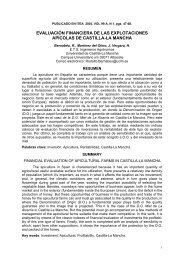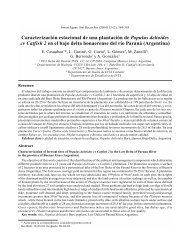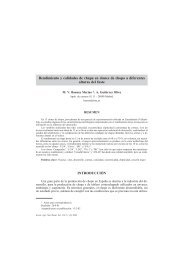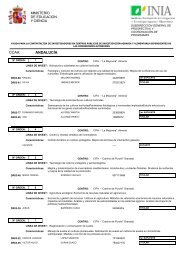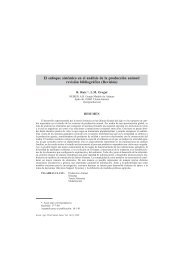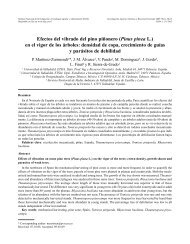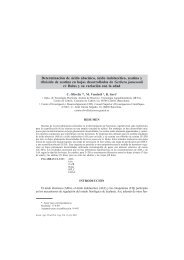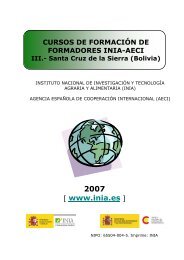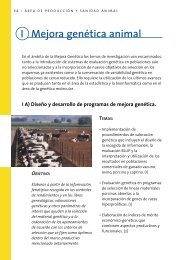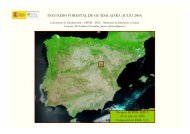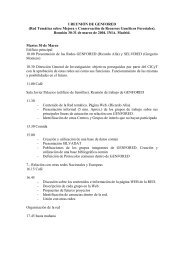Status of medicinal and aromatic plants in - Inia
Status of medicinal and aromatic plants in - Inia
Status of medicinal and aromatic plants in - Inia
Create successful ePaper yourself
Turn your PDF publications into a flip-book with our unique Google optimized e-Paper software.
PRESENTED PAPERS 143<br />
Documentation <strong>and</strong> databases<br />
The Central Database <strong>of</strong> the Slovene Plant Gene Bank<br />
Vladimir Meglič<br />
Agricultural Institute <strong>of</strong> Slovenia, Ljubljana, Slovenia<br />
Introduction<br />
In 1996 the M<strong>in</strong>istry <strong>of</strong> Agriculture, Forestry <strong>and</strong> Food started f<strong>in</strong>anc<strong>in</strong>g the Slovene Plant<br />
Gene Bank Programme with the goal to ma<strong>in</strong>ta<strong>in</strong>, evaluate, regenerate <strong>and</strong> preserve<br />
Slovenian autochthonous species, ecotypes, populations <strong>and</strong> l<strong>and</strong>races <strong>of</strong> agricultural,<br />
<strong>medic<strong>in</strong>al</strong> <strong>and</strong> <strong>aromatic</strong> <strong>plants</strong>, forest trees <strong>and</strong> other woody <strong>plants</strong> from Slovenian forests.<br />
They <strong>in</strong>clude Slovenian cultivars, old cultivars, l<strong>and</strong>races, various populations, clones <strong>and</strong><br />
l<strong>in</strong>es bred from autochthonous <strong>plants</strong> <strong>and</strong> ecotypes from the natural habitat important for<br />
food, agriculture <strong>and</strong> forestry (Černe et al. 1998).<br />
In the Slovene Plant Gene Bank Programme work<strong>in</strong>g with agricultural, <strong>medic<strong>in</strong>al</strong> <strong>and</strong><br />
<strong>aromatic</strong> <strong>plants</strong> (SPGB-AMAP) three <strong>in</strong>stitutions are <strong>in</strong>volved:<br />
- the Agronomy Department at the Biotechnical Faculty <strong>of</strong> the University <strong>of</strong> Ljubljana is<br />
responsible for the Fagopyrum, Zea mays, fruit trees (Malus, Pyrus, Juglans, Prunus), forage<br />
crops <strong>and</strong> <strong>medic<strong>in</strong>al</strong> <strong>and</strong> <strong>aromatic</strong> plant (MAP) collections;<br />
- the Institute for Hops <strong>and</strong> Brewery <strong>in</strong> Žalec is responsible for Humulus <strong>and</strong> <strong>medic<strong>in</strong>al</strong> <strong>and</strong><br />
<strong>aromatic</strong> plant collections;<br />
- the Agricultural Institute <strong>of</strong> Slovenia houses collections <strong>of</strong> gra<strong>in</strong> legumes, Allium, Solanum<br />
tuberosum, Triticum, Brassica, Lactuca accessions, forage crops, Rubus <strong>and</strong> Vitis.<br />
The Programme for conservation <strong>of</strong> forest genetic resources (Slovenian Forest Gene Bank)<br />
is led by the Slovenian Forestry Institute, Ljubljana.<br />
Multiplication, storage <strong>and</strong> evaluation<br />
Each year limited numbers <strong>of</strong> accessions are planted <strong>in</strong> the field for seed multiplication,<br />
characterization <strong>and</strong> evaluation. Dur<strong>in</strong>g the growth period morphological characteristics<br />
<strong>and</strong> disease susceptibility are recorded (Černe 1999).<br />
When mature, seeds are collected, cleaned <strong>and</strong> dried. Between 500 <strong>and</strong> 1000 seeds per<br />
accession are stored at +4°C <strong>in</strong> work<strong>in</strong>g collections. In addition samples are prepared for the<br />
base collection (long-term storage at –20°C) located at the Agricultural Institute <strong>of</strong> Slovenia.<br />
Genetic resources are also kept <strong>in</strong> <strong>in</strong> vitro conditions <strong>and</strong> <strong>in</strong> vivo <strong>in</strong> permanent plantations for<br />
hops, fruit, grapev<strong>in</strong>e <strong>and</strong> some MAP species.<br />
Collect<strong>in</strong>g missions<br />
Seed samples <strong>and</strong> passport data were obta<strong>in</strong>ed with the help <strong>of</strong> local elementary <strong>and</strong><br />
agricultural schools, the Agricultural Advisory Service, newspaper ads <strong>and</strong> farmers. Most <strong>of</strong><br />
the people who sent us samples filled out a questionnaire which provided necessary data<br />
<strong>and</strong> some additional <strong>in</strong>formation on local names <strong>and</strong> grow<strong>in</strong>g practices. Collect<strong>in</strong>g efforts<br />
are be<strong>in</strong>g cont<strong>in</strong>ued through collect<strong>in</strong>g missions throughout Slovenia. An important part <strong>of</strong><br />
the collect<strong>in</strong>g missions are jo<strong>in</strong>t missions with the Czech Republic <strong>and</strong> Croatia.




